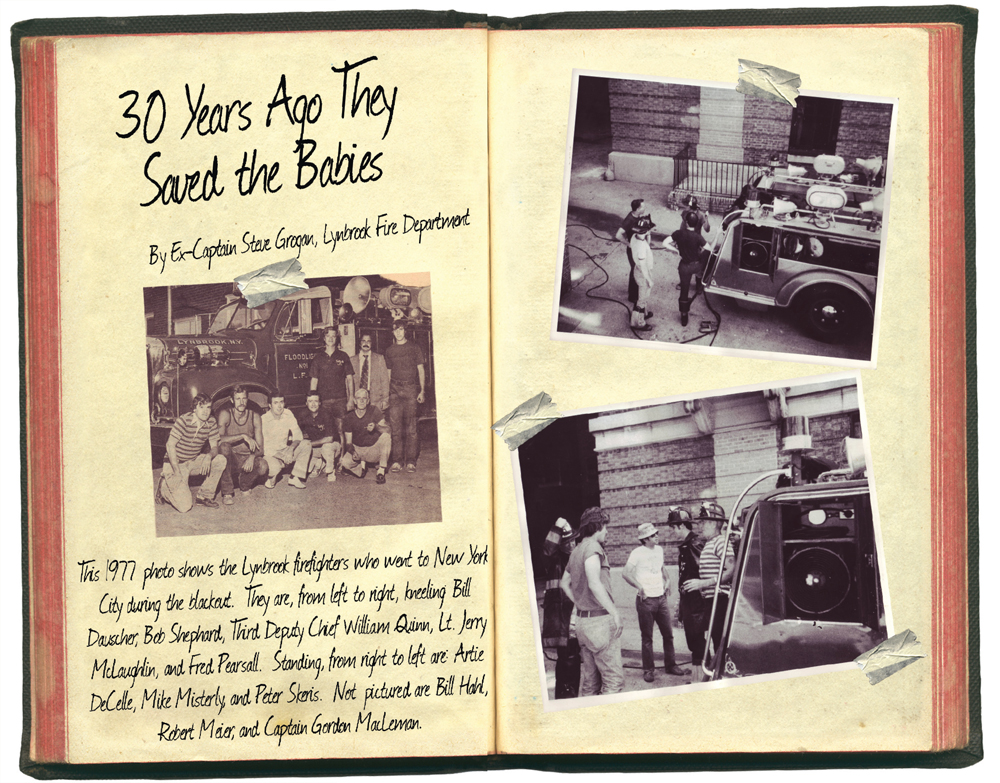|
Floodlight Saved The Babies
42 Years Ago
July 14th, 1977 From The Volunteer Firefighter Magazine story 2008 by Ex-Captain Steve Grogan
July 14, 2019 marks the 42nd Anniversary of the Lynbrook Fire
Department's Floodlight Unit's response to the City of New York for
the July 14, 1977 Blackout. Below is the story of that mutual
aid that appeared in FASNY's The Volunteer Firefighter Magazine in
2008. By coincidence, New York City had another semi-blackout
in Manhattan the night of July 13, 2019. In December 2007, the
Floodlight Unit of the Lynbrook Long Island Fire Department
celebrated an mportant day when their new Floodlight Command vehicle
was christened with the traditional wet-down ceremonies. But nothing
in the 70-year history of the unit was as significant as the day in
1977 when the unit responded on a rare request to New York City.
Their mutual aid response to the Big Apple Blackout of 1977 saved
the lives of 41 babies in the pediatric ward of a Brooklyn Hospital.
Here is that story of 30 years ago. Shortly after 3:00 a.m. on the morning of
the Big Apple Blackout, July 14, 1977, the Lynbrook volunteers of
the Floodlight Unit were awakened for their unit to respond to
Bellevue Hospital in Manhattan, which was in desperate need of a
generator to light up portions of the darkened hospital. The
Floodlight truck, back then, contained a 15 KW generator, along with
a portable 5 KW generator unit. The Floodlight members who responded
were Bill Dauscher, Bill Hahl, Bob Shephard, Captain Gordon
MacLeman, Lieutenant Jerry McLaughlin, Fred Pearsall, Peter Skeris,
Michael Misterly, Artie DeCelle, and Robert Meier. All of them were
also members of Lynbrook’s Tally-Ho Engine Company 3, where the
Floodlight Unit was then housed. The Floodlight responded to the
city that morning led by Third Deputy Chief William Quinn, a member
of Engine Company 1. Chief Quinn, in his chief ’s car, led the
Floodlight truck along the darkened highways to the Queens Midtown
tunnel where one lane was opened just for them to get into
Manhattan. The only lights were the headlights and the revolving red
lights on both fire vehicles. When the firefighters reached Bellevue, they
learned that another generator had been found but that one was
desperately needed at Brooklyn Jewish Hospital in the
Bedford-Stuyvesant section of Brooklyn. They were told that newborn
and premature babies were dying because of the lack of electricity
to keep them warm. They were also told that babies were being
wrapped in aluminum foil to help maintain their body temperature.
Somehow the Brooklyn Jewish Hospital’s back up generator had failed. Lieutenant McLaughlin would later tell New
York Newsday in a story that, “We had calls coming over the air that
babies were dying in the hospital.” The volunteers raced from
Manhattan to Brooklyn to help. Immediately upon their arrival at
Brooklyn Jewish Hospital, just after 4:00 a.m., Bob Shephard, a Long
Island Lighting Company employee, and Fred Pearsall, a New York
Telephone employee, ran a power line through a window of the
hospital and hooked up the truck’s generator to the hospital’s
electrical system. The first to receive electricity from the fire
truck were the incubators in the neo-natal nursery where 41 babies
were near death from the lack of heat. With the power back on, all
the babies would survive. One doctor would say in a Newsday article
that because babies have no fat they lose heat fast, which could
result in cardiac arrest or serious breathing problems. The volunteers also ran additional power
lines from the truck and, using portable lights, were able to light
up five floors of the hospital. One firefighter even crawled through
a window with a portable light so that a pharmacist could get the
prescribed medication he desperately needed from the darkened
pharmacy. They were also able to power the hospital’s paging system
so that doctors could be called. The volunteer firefighters would later say
that while they were working to get electricity into the building,
emergency room doctors were outside in the parking lot operating on
people under the lights of a small portable generator provided by
FDNY. One firefighter said that rioting was going on in the
surrounding neighborhood of the hospital and that gun shots could be
heard in the distant darkness. Lt. McLaughlin would also later tell
Newsday that about 60 people had surgery in the hospital parking lot
and that 36 of them had been hurt in the rioting. Lynbrook’s
Floodlight volunteers stayed at Brooklyn Jewish Hospital maintaining
the power into the hospital from their fire truck for over 15 hours
until they were relieved by the National Guard who brought in a
generator and took over. The president of Brooklyn Jewish
Hospital, then officially called, The Jewish Hospital and
Medical Center of Brooklyn, would later send a letter thanking the
Lynbrook Floodlight volunteers for their help, saying, “Because of
your help, 41 premature and extremely sick newborn infants are alive
today. On behalf of the families of these infants and our hospital,
we wish to thank you.” It is hard to believe that 30 years have
passed. All of those babies in the neo-natal nursery that day lived
and now would be grown ups themselves because of the efforts of
those Lynbrook volunteers. Of the original group of firefighters
that responded that day, only Bill Dauscher and Bill Hahl, are still
members of the Floodlight Unit and Tally-Ho Engine 3. The other
members have moved away, and Chief Quinn has passed away. About the Author: Steve Grogan is an Ex-Captain of the Floodlight Unit and a 40 year member of Tally-Ho Engine 3. He is the LFD’s Public Information Officer, a former Lynbrook Village Trustee, and a retired federal agent. From: They Saved the Babies March 2008. |
|
|
